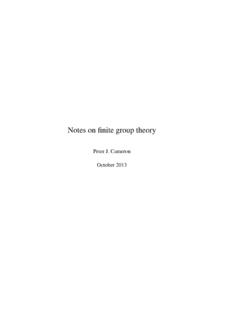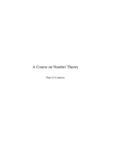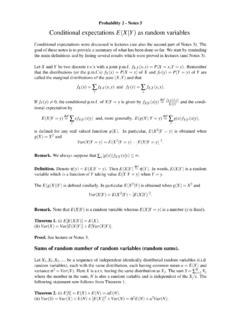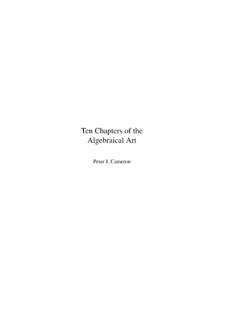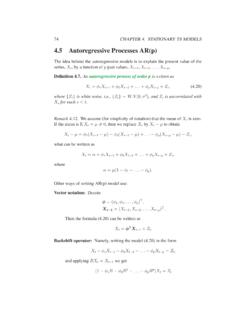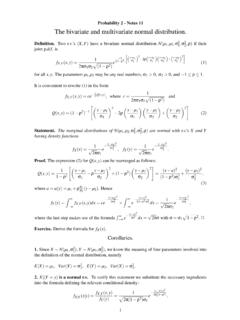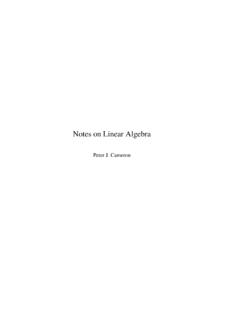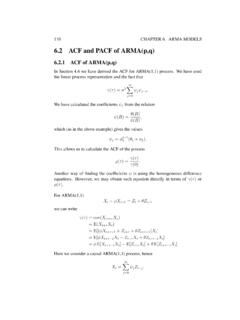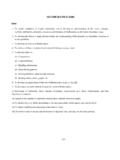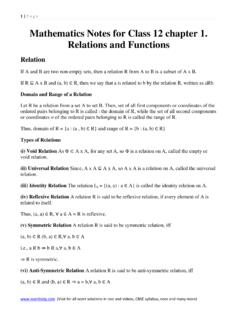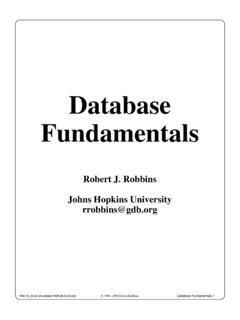Transcription of Solutions to Exercises Chapter 4: Recurrence …
1 Solutions to ExercisesChapter 4: Recurrence relations and generatingfunctions1(a) There arenseating positions arranged in a line. Prove that the numberof ways of choosing a subset of these positions, with no two chosen positionsconsecutive, isFn+1.(b) If thenpositions are arranged around a circle, show that the number ofchoices isFn+Fn 2forn 2.(a) Proof by induction. Ifg(n)denotes this number, then we haveg(1) =2=F2,g(2) =3=F3. (Forn=2, we cannot occupy both positions; but all otherchoices are possible.) Forn>2, we separate the seating selections into those inwhich the last position is unoccupied and those in which it is occupied. There areg(n 1)of the first kind. If the last position is taken, then the one before it mustbe free, and we have an arbitrary seating plan on the firstn 2 positions; so thereareg(n 2)of these. Henceg(n) =g(n 1) +g(n 2) =Fn+Fn 1=Fn+1,and the inductive step is proved.(b) Consider a particular position on the circle.
2 If it is unoccupied, we canbreak the circle at that point, and obtain a line withn 1 positions, which can befilled ing(n 1) =Fnways. If the position is occupied, then its neighbours oneither side are unoccupied, and (ifn 3) we can remove the position and its twoneighbours, obtaining a line ofn 3 positions which can be filled ing(n 3) =Fn 2ways. The same holds ifn=2, since there is just one seating plan with thegiven position occupied, andF0=1. So we haveFn+Fn 2seating plans in the following identities:(a)F2n Fn+1Fn 1= ( 1)nforn 1.(b)n i=0Fi=Fn+2 1.(c)F2n 1+F2n=F2n,Fn 1Fn+FnFn+1=F2n+1.(d)Fn=bn/2c i=0(n ii).(a) Induction: the result holds forn=1. Forn 2, we haveF2n Fn+1Fn 1=F2n (Fn+Fn 1)Fn 1= (Fn Fn 1)Fn F2n 1= (F2n 1 FnFn 2),so, ifF2n 1 FnFn 2= ( 1)n 1thenF2n Fn+1Fn 1= ( 1)n.(b) Induction. The result is true forn=0 (the empty sum is zero). Assumingit forn 1, we haven i=0Fi= (Fn+1 1) +Fn=Fn+2 1.(c) Again, induction. The result holds forn=1 by inspection.
3 Assume it forn; that is,F2n 2+F2n 1=F2n 2,Fn 2Fn 1+Fn 1Fn=F2n these equations and using the Fibonacci Recurrence , we getFn 2Fn+Fn 1Fn+1= (a) twice, this implies thatF2n 1+F2n=F2n. Now add this equation to thesecond displayed equation using the Fibonacci Recurrence to getFn 1Fn+FnFn+1=F2n+1.(d) Most easily, this follows from our original interpretation ofFnas the num-ber of expressions fornas an ordered sum of 1s and 2s. Such an expression withi2s will haven 2i1s, hencen isummands altogether; there are(n ii)ways tochoose the positions of the 2s in the sum. Now summing overigives the thatFnis composite for allodd n> 2(c),F2n+1=Fn(Fn 1+Fn+1); and ifn>1, then both factors are greaterthan thatb(n 1)/2c i=0Fn 2i=Fn+1 1forn proof is by an induction which goes fromn 2 ton, so the initial casesn=1 andn=2 must both be checked. Assuming the result forn 2, we haveb(n 1)/2c i=1Fn 2i= (Fn 1 1) +Fn=Fn+1 that every non-negative integerxless thanFn+1can be expressed in aunique way in the formFi1+Fi2+.
4 +Fir,wherei1,i2,..,ir {1,..,n},i1>i2+1,i2>i3+1, .. (in other words,i1,..,irare all distinct and no two are consecutive). Deduce Exercise 1(a).Follow the hint. If we had any expression of this form using Fibonacci num-bers belowFn, then we could if necessary replace the summands by larger onesand add new summands to obtainFn 1+Fn 3+..=Fn 1 (by Question 4). Sothe sum of the original expression was at mostFn 1. Hence any expression sum-ming tox, withFn x<Fn+1, must includeFn. Nowx Fn<Fn+1 Fn=Fn 1,so by induction there is a unique expression forx Fn, and hence forx(sincethe expression forx Fncannot involveFn 1, so does not contain consecutiveFibonacci numbers).Hence, the number of expressions of this form (that is, the number of ways ofchoosing a subset of the indices 1,2,..,nwith no two consecutive) is equal to thenumber of possible sums 0,1,..,Fn+1 1, that is,Fn+1, as asserted in 1(a).6 Fibonacci numbers are traditionally associated with the breeding of that a pair of rabbits does not breed in its first month, and that it pro-duces a pair of offspring in each subsequent month.
5 Assume also that rabbitslive forever. Show that, starting with one newborn pair of rabbits, the number ofpairs alive in thenthmonth the 0th and 1st months, one pair is alive, so the result is true forn=0, it holds forn 1. Then, in the(n 1)st month,Fn 1pairs of rabbits arealive, of whomFn 2were alive in the preceding month (and hence old enough tobreed), providingFn 2newborn pairs in thenth month. Thus, the total number ofpairs in thenth month isFn 1+Fn 2= that the number of additions required to compute the Fibonacci numberFnaccording to the inefficient algorithm described in the text isFn : check the result for smalln. NowFn 1takesFn 1 additions, andFn 2takesFn 1 1 additions; one further addition is required to combine them,giving in all(Fn 1) + (Fn 1 1) +1=Fn+1 1 (a) Prove thatFm+n=FmFn+Fm 1Fn 1form,n 0 (with the convention thatF 1=0).(b) Use this to derive an algorithm for calculatingFnusing onlyclognarith-metic operations.
6 (c) Given that multiplication is slower than addition, is this algorithm reallybetter than one involvingn 1 additions?(a) Induction onm. Form=0, the result is a tautology, and form=1 it is theFibonacci Recurrence . Form>1 we haveF(m+1)+n=Fm+n+F(m 1)+n=FmFn+Fm 1Fn 1+Fm 1Fn+Fm 2Fn 1=Fm+1Fn+FmFn 1,using the convention thatF 1=0 and the fact that, then, the relationFm=Fm 1+Fm 2holds also form=1.(b) The trick is to calculate pairs(Fn 1,Fn)of Fibonacci numbers, observ-ing that we can go efficiently from the pairs(Fm 1,Fm)and(Fn 1,Fn)to the pair(Fm+n 1,Fm+n)using (a). A cleaner way to express this is in terms of have(FnFn+1)A= (Fn+1Fn+2), whereAis the 2 2 matrix(0111). Hence(FnFn+1) = (1,1)An. By the analogue for powers of Russian peasant multiplica-tion ( Chapter 2, Exercise 12(iii)), we can findAnin about 2 log2nmatrix multi-plications, each requiring eight integer multiplications and four additions (thoughthis can be improved).
7 (c) SinceFnis exponentially large, the number of its digits is proportional ton. Hence a long multiplication involves a number of additions proportional ton,and we have not really made much saving over a method (a) Solve the following Recurrence relations .(i)f(n+1) =f(n)2,f(0) =2.(ii)f(n+1) =f(n) +f(n 1) +f(n 2),f(0) =f(1) =f(2) =1.(iii)f(n+1) =1+n 1 i=0f(i),f(0) =1.(b) Show that the number of ways of writingnas a sum of positive integers,where the order of the summands is significant, is 2n 1forn 1.(a) (i) Letg(n) =log2f(n). Theng(n+1) =2g(n),g(0) =1; sog(n) =2n(Section ), andf(n) =22n.(ii) The characteristic equation (see Section ) isx3=x2+x+1. This cubichas three distinct real roots , , , and so the general solution isf(n) =a n+b n+c n, wherea,b,care determined by the three equationsa+b+c=1,a +b +c =1,a 2+b 2+c 2=1.(iii) We havef(1) =1, since the empty sum is zero. Forn 1, we havef(n+1) =1+n 1 i=0f(i) =(1+n 2 i=0f(i))+f(n 1) =f(n) +f(n 1),and so by inductionf(n)is the Fibonacci numberFn.
8 (b) There is one expression consisting of the single numbern. Any otherexpression ends with some positive numberj<n, preceded by an expressionwith sumn j; so the numberf(n)of expressions satisfiesf(n) =1+n 1 j=1f(n j) =1+n 1 i=1f(i).Just as in (a)(iii), we find thatf(n+1) =f(n) +f(n) =2f(n). Sincef(1) =1,we havef(n) =2n 1, as numberf(n)of steps required to solve the Chinese rings puzzle withnrings satisfiesf(1) =1 andf(n+1) ={2f(n),nodd,2f(n) +1, thatf(n+2) =f(n+1) +2f(n) +1. Hence or otherwise find a formulaforf(n).Ifnis odd, thenf(n+2) =2f(n+1) +1 andf(n+1) =2f(n); ifnis even,thenf(n+2) =2f(n+1)andf(n+1) =2f(n) +1. So the result holds in is not a pure Recurrence relation because of the added 1. But if wesetg(n) =f(n) +12, theng(n+1) +2g(n) =f(n+1) +2f(n) +32=g(n+2).The characteristic equation isx2=x+2, with Solutions 2 and 1, sog(n) =a2n+b( 1)n. The initial valuesg(1) =32andg(2) =52yielda=23andb= (n) =232n 16( 1)n (a) Lets(n)be the number of sequences(x1.)}
9 ,xk)of integers satisfying1 xi nfor alliandxi+1 2xifori=1,..,k 1. (The length of the se-quence is not specified; in particular, the empty sequence is included.) Prove therecurrences(n) =s(n 1) +s(bn/2c)forn 1, withs(0) =1. Calculate a few values ofs. Show that the generatingfunctionS(t)satisfies(1 t)S(t) = (1+t)S(t2).(b) Letu(n)be the number of sequences(x1,..,xk)of integers satisfying1 xi nfor alliandxi+1> ij=1xjfori=1,..,k 1. Calculate a few valuesofu. Can you discover a relationship betweensandu? Can you prove it?(a) We haves(0) =1, since only the empty sequence occurs. Forn>0, dividethe sequences counted bys(n)into two classes: those not containingn, and thosecontainingn. There ares(n 1)of the first class. For the second, all terms otherthannare at mostn/2, so such a sequence is obtained from a sequence of numberswith 1 xi bn/2candxi+1 2xiby adjoiningn; so there ares(bn/2c)of Recurrence relation (t) = s(n)tn, then we haveS(t) =tS(t) + (1+t)S(t2);6for the coefficient oftnon the right iss(n 1) +s(bn/2c), and the constant termon both sides is equal to 1.
10 (b) The relationship isu(n) u(n 1) =s(n)/2 forn 2. The proof is quiteintricate, and depends on defining another sequencev(n)as follows:v(n)is thenumber of sequences(x1,..,xk)of positive integers which satisfyxi> i 1j=1xjforalli kand ki=1xi=n. Now such a sequence must have last termxk>n/2, andis obtained by taking a sequence with sumn xk b(n 1)/2cand appendingxkto it. So we have the recurrencev(n) =b(n 1)/2c i=1v(i).It follows from this thatv(2n) =v(2n 1) =v(2n 2) +v(n 1)for alln> we claim thatv(2n) =s(n)/2 for alln 1. This is proved by induction,being true forn=1. Assuming the result forn 1, we havev(2n) =v(2n 2) +v(n 1)=s(n 1)/2+s(bn/2c)/2=s(n)/2,and the induction goes (n) u(n 1)is the number of sequences satisfying the specificationforuwhich have last termn. These are obtained by appendingnto a sequencewith sum strictly smaller thann; so we haveu(n) u(n 1) =n 1 i=0v(i)=v(2n)=s(n) :Sequences satisfying this condition are calledsuperincreasing; theyarose in the first example of a public-key cryptosystem, the Merkle Hellmanknapsack two sequencessanduoccur as numbers M1011 and M1053 in theEncy-clopedia of Integer Sequences, where further references can be found, or you canfind them in the online version here (fors) and here (foru).


